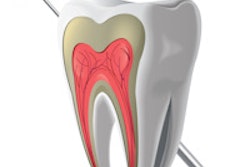
Root canal therapy can reduce multiple dimensions of pain, including intensity, duration, and its interference with daily activity, according to a new practice-based research network study in the Journal of Endodontics (November 2014, Vol. 40:11, pp. 1738-1745).
While a number of studies have looked at root canal's effect on pain intensity, the procedure's effect on other dimensions of pain has not been examined, according to lead study author Alan S. Law, DDS, PhD, from the division of endodontics at the University of Minnesota School of Dentistry, and colleagues. Dr. Law and his co-authors are part of the National Dental Practice-Based Research Network Collaborative Group, which includes practitioner, faculty, and staff investigators who contributed to the study.
"No studies have compared the effect root canal therapy has on pain duration and interference in daily living by measuring these pain-related factors before and after treatment using standard methods," they wrote. "Measuring multiple dimensions of the pain experience provides greater insight about the problem."
Therefore, the authors conducted a large multisite prospective observational study within the National Dental Practice-Based Research Network. The study included 62 member dentists, 46 of whom were general practitioners and 16 were endodontic specialists. The practitioners encompassed five geographic regions, including Alabama/Mississippi, Florida/Georgia, Minnesota, Oregon/Washington, and Denmark/Sweden.
The participating dentists looked at a total of 655 patients between the ages of 19 and 70 who had a permanent tooth that required root canal therapy. Data was collected immediately before and after the procedure to assess the preoperative and intraoperative state and then one week after treatment to assess the postoperative state. Of the treated teeth, 59% were maxillary and 89% were posterior.
The majority of the study participants were white and college-educated, with an annual household income of $30,000 or more, and 81% had dental insurance.
The Graded Chronic Pain Scale was used to measure pain intensity, and the range was 0 to 10, with 0 meaning no pain and 10 indicating pain as bad as could be.
The proportion of patients reporting severe or worst pain intensity (7 or higher) was reduced by 31% after the procedure, while the proportion reporting no pain increased by 15%, the authors noted.
On average, patients with preoperative pain intensities of 4 or higher experienced considerable reductions in pain, whereas those with mild pain (1 to 3) had no change and those with no preoperative pain experienced a modest but significant increase in pain.
“Patients presenting with moderate to severe pain intensities ... reported reductions in their pain intensity.”
Although overall averages identified statistically and clinically significant reductions in pain intensity, subgroup analyses were used to further elucidate the nature of these changes, the authors noted.
"Patients presenting with moderate to severe pain intensities, comprising nearly two-thirds of study patients, reported reductions in their pain intensity," they wrote. "In contrast, patients with mild preoperative pain reported no signicant change in pain intensity, and those with no pain reported a modest increase in pain intensity."
These differences have implications for treatment decisions, in that patients could be better informed about their pain-related prognosis, the study authors noted.
As for pain duration, the researchers found patients had a reduction in the number of days in pain from the week before the procedure compared with the week after, which includes procedure-related inflammation.
"Given that pain duration contributes to orofacial pain and impacts patient reporting of other outcome measures, as well as serving as a measure of chronicity, its importance should not be overlooked," the authors wrote.
The mean change in number of days patients experienced tooth pain, from the preoperative week to the postoperative week was -1.5 ± 3.4. The mean change for interference in daily activities was -0.9 ± 2.9, indicating that tooth pain interfered significantly less with daily activities postoperatively.
Although an overall mean reduction of 0.2 days of interference does not appear large, it represents approximately five hours less interference above and beyond the recovery time experienced post-treatment, according to the authors.
They added that pain-related interference with activities caused by tooth pain has infrequently been studied, which is surprising because it is considered a major contributor to quality of life and has been determined to be an important outcome.
"The results showed an overall therapeutic effect of reducing patients' pain intensity, duration, and related burden when receiving root canal therapy in this practice-based research network, thus supporting root canal therapy for the treatment of odontogenic pain in general clinical settings," the authors concluded.



















